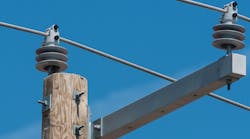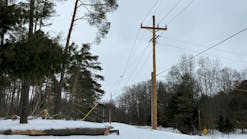Polyethylene Insulators are the Best Choice for Covered Conductors
Over the years, Hendrix has maintained that porcelain insulators (and porcelain spacers) should not be used with covered conductor. This is due to the dielectric incompatibility between the two materials (polyethylene and porcelain). This short discussion provides a simple explanation of that incompatibility, as well as its consequences.
When covered conductors are installed in open air under normal operating conditions, very little voltage appears across the covering. In fact, the voltage at the covering surface is almost full line voltage and there is negligible current passing through the insulation. When the cable comes into contact with a partially grounded object (tree branch, wet leaves, etc.), this situation changes. Now there is a path to ground, and, a current flow. Hendrix cable is designed to withstand momentary contact without detrimental effects on either the performance of the system or its useful service life. Covered conductor is not intended for permanent contact with grounded objects, since it will eventually cause covering damage and lead to system failure.
In general, system construction requires cables to be supported. In our case, the supporting devices for the covered conductor are spacers and insulators. When a polyethylene covered cable comes in contact with a porcelain insulator, there is also a path to ground. That path, made up primarily by the insulator, is a mixture of resistance, inductance, and capacitance. Unfortunately, since the porcelain is a very different insulating material than the polyethylene, there is an electric field discontinuity at the interface where the cable touches the porcelain.
This contact point at the interface of the cable and porcelain insulator begins to experience partial discharge, or corona, which results from an unequal sharing of the voltage across the insulator and the cable covering. This corona first begins to show itself as a high frequency RIF noise, which causes interference in televisions and AM radios. The partial discharge at the cable to porcelain insulator interface is creating microscopic holes in the polyethylene surface. After more time goes by, these microscopic holes progress to visible tunnels. After still more time, the aluminum strands from the conductor starts to become pitted and begins to exit through the tunnels created by the partial discharge. What has started out as, say, a 7 strand conductor, eventually becomes a 6 strand, then a 5, then a 4, etc. Then, on a perfectly sunny summer day, when everyone turns on his or her air conditioner, the conductor suddenly finds itself severely overloaded from an ampacity standpoint, and simply severs at the insulator location. Linemen dispatched to the site report that there appears to be no damage, except that the conductor melted in two. This event is known in the industry as a “blue sky” failure.
The photo below shows a roll of cable retired from the field. The center conductor shows where the cable was attached to a porcelain insulator. This system was installed for 35 years and is an extreme case of insulation degradation and strand damage due to dielectric incompatibility. The utility long ago switched to polyethylene insulators but still has some older systems with the porcelain.
When a polyethylene insulator is used, there is no dielectric incompatibility, and the voltage is evenly shared along the insulation system avoiding the problem of current discharges at the insulator to cable interface.
Dielectric incompatibility and corona are also influenced by voltage level. Namely, the higher the voltage the greater the discharge and the shorter the time to covering damage or failure. On a 15kV system, it might take 20-30 years to actually see insulation degradation. On a 35kV system however, the time for the corona to cause a burndown may be on the level of years or even months.
It has been argued that in a low lightning activity area like the northeast USA, this insulation degradation over time is less of a problem. In fact, this is not true. For every year that a cable suffers this partial discharge from being installed on a porcelain insulator, its insulation deteriorates. It experiences a reduction in BIL, which will make it much more susceptible to burndown from lightning. It also experiences an increase in surface current, which is a danger to wildlife, as well as linemen who might come into contact with the cable, and is a further debilitating factor subtracting from its useful service life.
When this compatibility problem was discovered in the 1960’s, we went into the laboratory and came up with the HPI (Hendrix Polyethylene Insulator) as the clear solution to the problem. Some utilities, choosing to keep on using the porcelain insulators, simply took the brute force approach, and stripped back the insulation at all interfaces between the cable and insulator. The cost of a lineman’s time in stripping the cable insulation at the insulator interface is greater than the small price delta between the HPI and the porcelain insulator. Also, this defeated the whole purpose of the covered aerial system, because they were stripping it at every pole and basically converting it to a bare wire system. Why specify and pay for a covered system and them convert it to a bare system? The real tragedy was an unforeseen one, however, as the junction point between the covered and the bare (stripped) conductor became a point of lightning burndowns. Junctions (whether bare to covered, or bare to URD, etc.) must always be protected by lightning arresters. In the case of stripping cable insulation for the purpose of installing it on porcelain insulators, however, it is not practical to install three lightning arresters at every pole.
The utilities that were stripping the insulation at every pole to install the covered conductor on porcelain insulators (and were suffering frequent burndowns), took the next leap of unscientific brute force. A connector manufacturer came up with what is best described as a sacrificial anode, called an “L Node” by some, and an “arc protective device” by others. This is basically a lower melting point blob of zinc mixed in with aluminum, installed on a connector at the location where the insulation has been stripped. The purpose was so that when a lightning surge passes by the junction of the bare to covered wire, the energy which becomes concentrated at this junction is absorbed by the lower melt point metal. Unfortunately, if the location sees a few lightning strikes (or one high energy strike), there is no sacrificial anode remaining for the next lightning event, since it melted away on the prior event, and a burndown occurs. Overall, the strategy of a covered system stripped at every pole wastes money on labor to strip each phase, imposes extra material costs for sacrificial anodes, suffers a loss of reliability from temporary faults and burndowns, loses the advantage of compact construction, and is prone to premature loss of useful service life.
In summary, Hendrix Polyethylene Insulators are the solution to avoid compatibility problems with all types of covered conductors including tree wire, spacer cables and weatherproof wires. Tie Top HPI’s use a TPR covered soft drawn aluminum tie wire to secure the conductor to the insulator. When Vice Top insulators are used, the jaws are selected to insure compatibility.
Sponsored by:




